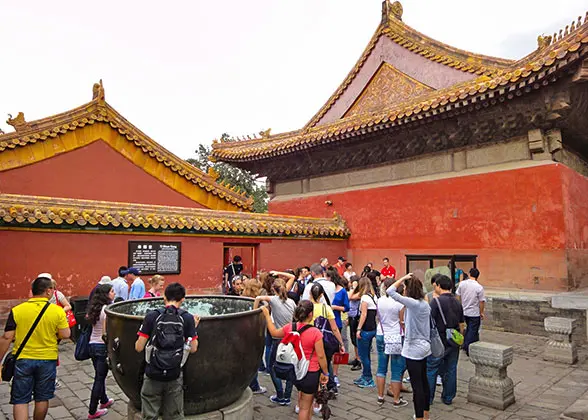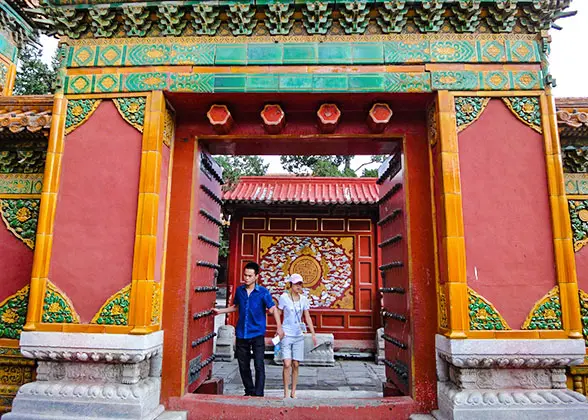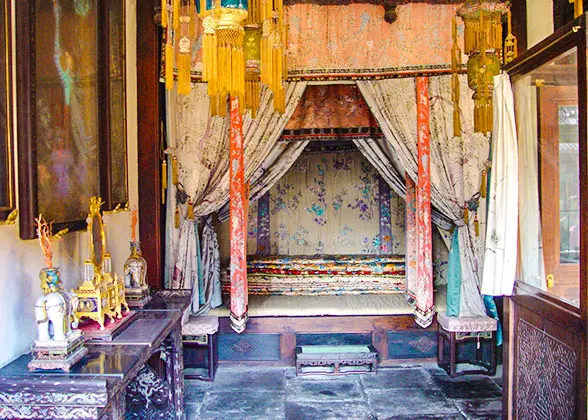Six Western Palaces (Xiliugong)
Together with Six Eastern Palaces, the Six Western Palaces accommodated the emperor's wives and concubines. From the Emperor Yongzheng (reign time 1722-1735) of the Qing Dynasty (1644-11), the empress no long lived in the Palace of Earthly Tranquility, but chose one of the twelve palaces as her abode. Comparatively, the palaces in the Eastern Six Palaces are neat and keep their original layout basically as they were first built in the Ming Dynasty (1368-1644). It lies to the north of Yangxindian (The Hall of Mental Cultivation). They form a group with three palaces on either side of an alley that runs from north to south. Emperor Dowager Cixi spent most of her life in them, so, she made many alterations to the buildings in this region.
 |
| Six Western Palaces |
The Six Western Palaces include Palace of Eternal Longevity (Yongshougong), Palace of Earthly Honor (Yikungong), Palace for Gathered Elegance (Chuxiugong), Hall of the Supreme Principle (Taijidian), Palace of Eternal Spring (Changchungong) and Palace of Universal Happiness (Xianfugong). Each has its own courtyard, a front hall, a rear hall and annexes. Most of them are displayed to the public with their untouched and original settings.
With two finely cast bronze dragons and two bronze deer standing on stone plinths outside, the Palace for Gathered Elegance (Chuxiugong) is the most famous of the six since the notorious Empress Dowager Cixi lived here for a long period. It was the most important in her life. When she was first selected to enter the Forbidden City and then received a title from the emperor, it was given to her as her residence. She moved out when she became the empress dowager upon the death of her husband Emperor Xianfeng (reign time 1850-1861).
In fact, the Palace for Gathered Elegance was for ordinary concubines of the Ming emperors. Qing Emperor Jiaqing’s two empresses lived here successively. Its status rose in importance especially due to Cixi. Cixi exercised power from behind the throne by her dominating influence over a weak emperor. She spent a huge amount of money upon the refurbishment and decoration, making it the most luxurious for the celebration of her 50th birthday in 1884. The last owner was the last empress of the Qing Dynasty, Wan Rong. She moved there after her marriage to Emperor Xuantong (also known as Puyi). In an autumn day of 1924 when Wan Rong and Puyi were quietly conversing here, they were driven from the Forbidden City by the National Revolutionary Army. Visitors can see Puyi’s life exhibition here now. The back hall, Lijingxuan, has an opera stage where Puyi once held western style banquets.
Palace of Eternal Longevity was repaired several times but retained its layout as when first built in the Ming Dynasty. It was for concubines. However, because of close distance to Palace of Heavenly Purity and Hall of Mental Cultivation, some of the emperors lived here temporarily. By the end of the Qing, it had become a storeroom of imperial furniture.
 |  |
To celebrate Cixi’s 59th birthday, Palace of the Queen Consort was renovated in 1884. Its back hall was changed into a connecting hall between it and Palace for Gathering Essence. Previously, Cixi had accepted the ministers’ congratulations when she moved to the Palace of Gathering Essence at age of 50. This place was also the venue where Emperor Guangxu selected his wives.
Hall of the Supreme Principle was originally called Weiyang Palace and then changed to Qixiang Palace (Palace of Starting Auspiciousness) by Ming Emperor Shizong (reign time1522-1566) for his father was born there. Its present name originated in the late Qing Dynasty. It was rebuilt on the occasion of Cixi’s 40th birthday. Its back hall became the independent hall as a connection to the Palace of Eternal Spring by a veranda. The porch behind the connecting hall could be an opera stage. Emperor Qianlong (reign time 1735-179) passed his crown here to his son, Emperor Jiaqing (reign time 796-1820). Peking opera performances were put on here for half a month to celebrate Cixi’s 50th birthday. Emperor Guangxu’s empress Longyu lived here when she became the empress dowager till her heath.
The Palace of Eternal Spring was once the residence of Emperor Qianlong’s empress. During the reign of Qing Emperor Tongzhi (reign time 1861-875), it was home to both empress dowagers, Cixi and Ci’an. It then became the residence of Cixi when Ci’an moved to the Palace of Purity. The couplets on the column of the hall all flatter Cixi to mark her birthdays.
Palace of Universal Happiness also has two layers of courtyard but it has a glaze-tiled main gate and a hip roof (highest level roof style in ancient Chinese building) with yellow glazed titles. So, it has the senior status among the six. It was once the temporary residence for Emperor Qianlong, although used as a storeroom for fur garments during the late Qing dynasty.
![]() Next:
Next:![]() Go northeast to tour the Imperial Garden (Yuhuayuan);
Go northeast to tour the Imperial Garden (Yuhuayuan);
![]() Go south to see the Hall of Mental Cultivation (Yangxindian).
Go south to see the Hall of Mental Cultivation (Yangxindian).
![]() Note:
Note:![]() On the north side is the Studio of Cleansing Fragrance (Shufangzhai), which is not open to tourists yet.
On the north side is the Studio of Cleansing Fragrance (Shufangzhai), which is not open to tourists yet.
![]() On the northwest are the Palace of Established Happiness (Jianfugong) and the Palace of Many Splendors (Chonghuagong), which are not open to tourists yet.
On the northwest are the Palace of Established Happiness (Jianfugong) and the Palace of Many Splendors (Chonghuagong), which are not open to tourists yet.![]() Further Reading: How to visit the Forbidden City
Further Reading: How to visit the Forbidden City